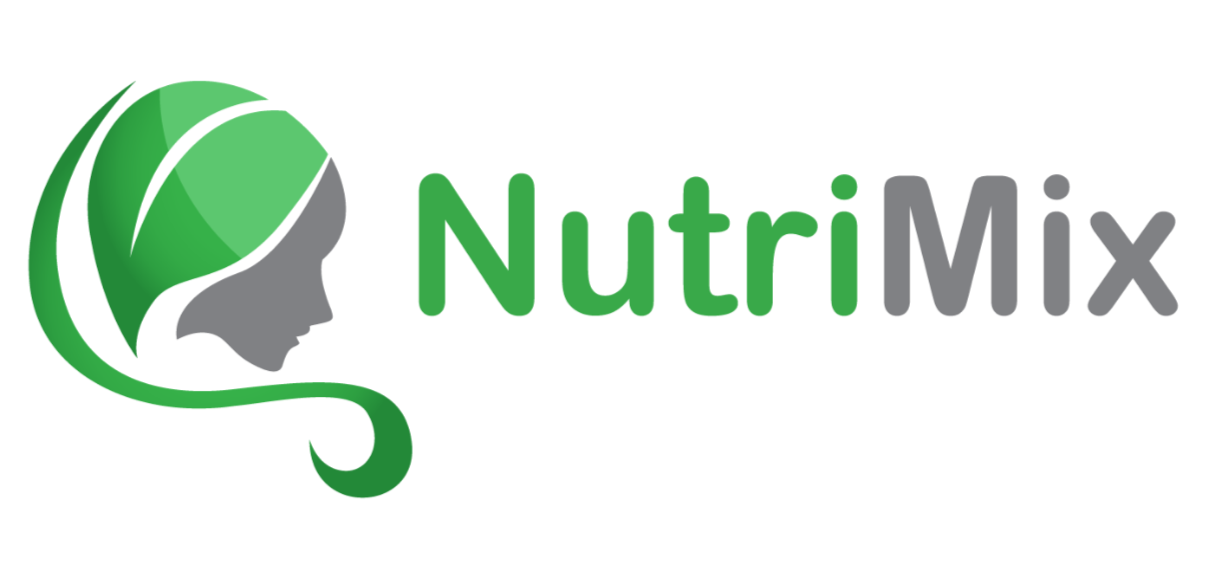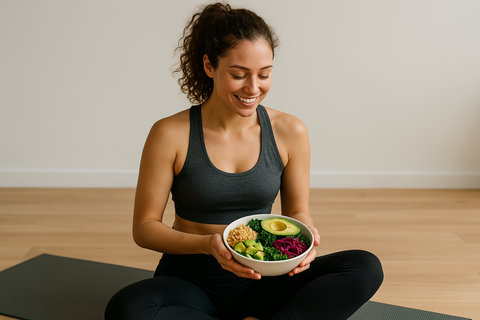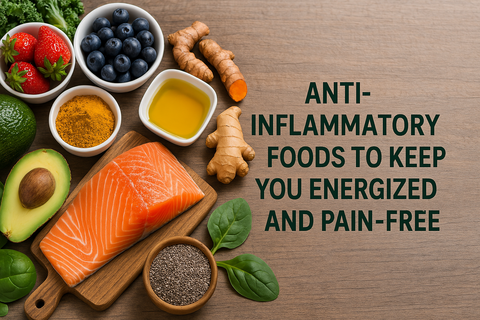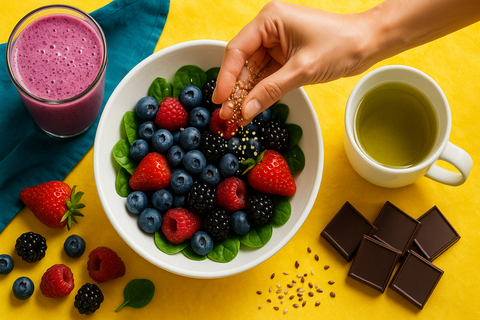You’ve heard “trust your gut,” but did you know your gut literally talks to your brain—and even to your muscles? Scientists now recognize the gut‑brain‑muscle axis as a three‑way communication network that influences mood, immunity, energy metabolism, recovery, and even hormonal balance. With mental health challenges on the rise and more people chasing performance gains, understanding how the trillions of microbes in your digestive tract shape your well‑being is no longer niche—it’s essential.
In this post, we’ll:
-
Unpack the biology behind the gut‑brain and gut‑muscle dialogues
-
Highlight key research linking microbiome shifts to mood disorders and recovery rates
-
Share nine (yes, we’re adding two!) science‑backed strategies to optimize your flora
-
Offer a detailed gut‑friendly power bowl recipes
-
Answer common FAQs and show you how to track your progress
Whether you’re an athlete chasing PRs, someone managing stress or depression, or simply seeking greater vitality, you’ll walk away with practical tools to cultivate a thriving inner ecosystem.
What Is the Gut‑Brain‑Muscle Axis?

1. Neural Pathways
-
Vagus nerve: The “superhighway” carrying signals from your gut lining to your brainstem. Microbial metabolites stimulate vagal afferents, influencing mood and stress responses.
-
Enteric nervous system (ENS): Often called the “second brain,” it contains over 100 million neurons lining your gut, capable of autonomous reflexes and direct communication with the CNS.
2. Immune & Endocrine Crosstalk
-
Cytokines & chemokines: Gut bacteria modulate immune cells in the gut‑associated lymphoid tissue (GALT), affecting systemic inflammation—a key driver of depression and delayed muscle repair.
-
Hormones: Certain microbes can influence cortisol (the stress hormone) levels via the HPA axis, and even impact anabolic hormones like testosterone and IGF‑1, critical for muscle growth.
3. Microbial Metabolites
-
Short‑chain fatty acids (SCFAs): Acetate, propionate, and butyrate are produced when fiber is fermented in the colon. They:
-
Strengthen the gut barrier (reducing “leaky gut”)
-
Serve as fuel for colonocytes and enter the bloodstream to exert anti‑inflammatory effects
-
Cross the blood‑brain barrier to influence neuroinflammation
-
-
Neurotransmitters: Gut microbes synthesize GABA, serotonin precursors (tryptophan metabolites), dopamine, and histamine, directly affecting brain chemistry.
Mood Matters: Microbiome & Mental Health

Serotonin & the “Feel‑Good” Axis
-
Fact: ~90 % of your body’s serotonin is produced in the gut lining, not the brain. Gut bacteria like Enterococcus and Streptococcus convert dietary tryptophan into serotonin precursors, which then circulate to the CNS.
-
Impact: Low microbial diversity is linked to reduced serotonin signaling, which manifests as anxiety, insomnia, and appetite changes.
Dysbiosis, Inflammation & Depression
-
Leaky gut: When tight junctions loosen, bacterial components (LPS) enter the bloodstream, triggering systemic inflammation. Chronic inflammation can impair neurogenesis in the hippocampus and worsen mood disorders.
-
Case study: In a double‑blind trial, 40 adults with mild‑to‑moderate depression took a multi‑strain probiotic (including Lactobacillus helveticus and Bifidobacterium longum) for eight weeks. They experienced a 50 % greater reduction in Beck Depression Inventory scores versus placebo—and lower cortisol levels.¹
Stress Resilience & HPA Modulation
-
Psychobiotics: A class of probiotics shown to reduce stress‑induced cortisol spikes. Animal models reveal that germ‑free mice have exaggerated HPA axis responses to stress—normalized when colonized with Bifidobacterium infantis.²
-
Takeaway: Cultivating a balanced flora isn’t just for digestion—it’s your frontline defense against chronic stress.
Muscle Recovery & Strength: The Hidden Link

Nutrient Bioavailability
-
Protein digestion: Certain species (e.g., Bacteroides thetaiotaomicron) secrete proteases that help break down complex proteins into absorbable amino acids, supporting muscle protein synthesis.
-
Vitamin synthesis: Gut bacteria produce B‑vitamins (B₁₂, B₂, folate) essential for energy metabolism and red blood cell formation—key for oxygen delivery to working muscles.
Inflammation & Repair
-
SCFAs in action: Butyrate downregulates NF‑κB, a pro‑inflammatory transcription factor, speeding up recovery by reducing cytokine‑driven muscle damage.
-
Athlete data: In a randomized study, rugby players given a prebiotic‑probiotic combo for four weeks reported 30 % less delayed‑onset muscle soreness (DOMS) and maintained performance metrics better than controls.³
Hormonal Interplay
-
Testosterone & IGF‑1: Emerging evidence suggests a diverse microbiome supports healthier testosterone and IGF‑1 levels, though mechanisms remain under investigation. Early data hint at microbial modulation of enterohepatic circulation of steroid hormones.
9 Ways to Feed Your Gut—and Your Gains
-
Diversify Your Fiber (30–50 g/day)
-
Why: Different fibers feed different microbes.
-
How: Rotate legumes (lentils, chickpeas), whole grains (oats, barley), fruits (apples, pears), and veggies (broccoli, artichokes).
-
-
Embrace Fermented Foods
-
How: Start with 1 tbsp/day of kimchi, kefir, kombucha, or sauerkraut. Work up to ¼ cup servings.
-
Prebiotic Powerhouses
-
Why: Non‑digestible fibers that selectively fuel beneficial species.
-
How: Incorporate 2–3 servings/week of onions, garlic, leeks, asparagus, chicory root, and Jerusalem artichokes.
-
-
Polyphenol Punch
-
Why: Plant compounds that boost Akkermansia and Faecalibacterium while suppressing pathogens.
-
How: Sip green tea (2–3 cups/day), snack on dark chocolate (≥70 % cacao), and add berries to breakfast.
-
-
Limit Ultra‑Processed Foods
-
Why: Emulsifiers and artificial sweeteners disrupt microbial diversity and gut barrier function.
-
How: Swap packaged bars for homemade energy balls; choose whole‑food snacks.
-
-
Smart Supplementation
-
Why: Targeted strains can fill dietary gaps.
-
How: Look for multi‑strain products with clinically studied microbes (e.g., L. rhamnosus GG, B. longum). Pair with a broad‑spectrum prebiotic (inulin, FOS).
-
-
Mind‑Body Practices
-
How: Practice daily meditation (5–10 min), yoga, or breathwork to regulate your HPA axis.
-
Regular Movement
-
Why: Exercise independently promotes microbial diversity and SCFA production.
-
How: Combine aerobic (30 min, 3×/week) with resistance training; even walking boosts butyrate producers.
-
-
Adequate Sleep
-
Why: Sleep deprivation shifts microbial composition toward pro‑inflammatory species.
-
How: Aim for 7–9 hours nightly; maintain a consistent sleep schedule and bedtime routine.
-
Recipe Spotlight: Gut‑Friendly Power Bowl

Ingredients (serves 2)
-
1 cup cooked quinoa (resistant starch when cooled)
-
1 can chickpeas, drained & roasted with 1 tsp paprika & ½ tsp sea salt
-
2 cups steamed kale, lightly sautéed in olive oil & garlic
-
½ cup sauerkraut (unpasteurized)
-
1 avocado, sliced
-
Tahini‑lemon dressing:
-
2 tbsp tahini
-
Juice of ½ lemon
-
1 tsp apple cider vinegar
-
Water to thin
-
Directions
-
Prep quinoa: Cook per package, then spread on a tray to cool (boosts resistant starch).
-
Roast chickpeas: Toss with spices; bake at 400 °F for 20 min until crisp.
-
Sauté kale: Warm olive oil in a pan, add garlic, then kale; cook until just wilted.
-
Assemble bowls: Divide quinoa and kale between bowls, top with chickpeas, sauerkraut, and avocado.
-
Drizzle dressing: Whisk tahini ingredients; adjust thickness, then finish each bowl.
Nutrition per serving (approx.):
550 kcal • 18 g protein • 60 g carbs (12 g fiber) • 28 g fat
Monitoring Your Microbiome: Signs & Testing
Subjective Markers
-
Mood stability: Fewer anxiety episodes, improved sleep quality, steadier energy.
-
Recovery metrics: Shorter DOMS, maintained strength outputs in workouts.
-
Digestive comfort: Regular, pain‑free bowel movements; less bloating or gas.
Objective Testing
-
At‑home microbiome kits: Companies like Viome or DayTwo offer species‑level breakdowns and personalized food recommendations.
-
Metabolomic panels: Measure SCFA levels and inflammatory markers in stool.
-
Blood biomarkers: CRP (inflammation), zonulin (gut permeability), and cortisol (stress).
Keep a simple gut journal logging foods, mood scores (1–10), sleep quality, and workout recovery. Over 4–6 weeks, patterns emerge—helping you fine‑tune your strategy.
Emerging Therapies & Future Directions
-
Fecal Microbiota Transplantation (FMT): Experimental in mood disorders; early trials show promise in treatment‑resistant depression by resetting dysbiotic guts.
-
Postbiotics: Heat‑killed microbes or their metabolites (SCFAs, peptides) may offer benefits without live organisms—an area of active research.
-
Personalized “psychobiotics”: Next‑gen probiotics tailored to individual microbial signatures for targeted mood and performance support.
FAQs
Q: How long until I notice benefits?
A: Subjective improvements (mood, digestion) often appear within 2–4 weeks. Muscle recovery gains may take 4–8 weeks of consistent pre/probiotic use and fiber diversity.
Q: Can I overdo fiber?
A: Ramp up slowly. Sudden high‑fiber intake can cause gas and bloating. Increase by 5–10 g/week, paired with extra water.
Q: Are supplements necessary if I eat well?
A: Whole foods should be your foundation. Supplements can help bridge gaps—especially after antibiotics, during heavy training, or under high stress.
Q: What if I have IBS or SIBO?
A: Work with a healthcare provider. Some fermentable fibers can exacerbate symptoms. A targeted elimination (FODMAP) followed by reintroduction may help identify triggers.
Conclusion & Next Steps
The gut‑brain‑muscle axis is a frontier of wellness—linking your mood, immunity, and performance through a microscopic community inside you. By diversifying fibers, embracing fermented and polyphenol‑rich foods, managing stress, and prioritizing sleep and movement, you’ll nourish both your microbiome and your body’s resilience.
👉 This week: Pick two strategies—perhaps a daily probiotic‑rich snack and a 5‑minute morning meditation—and track your mood and recovery in a journal. Let’s build a stronger, healthier community from the inside out!



